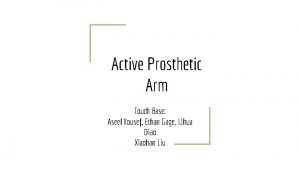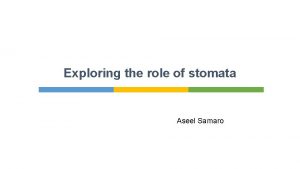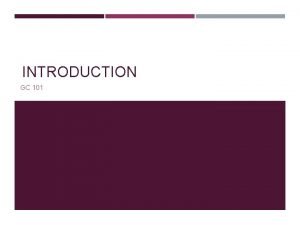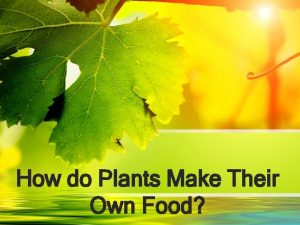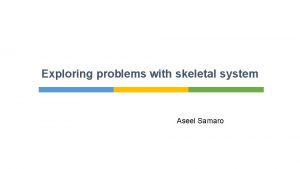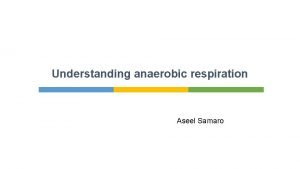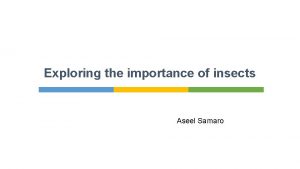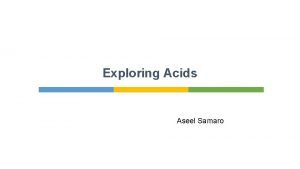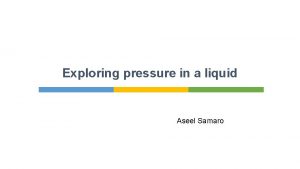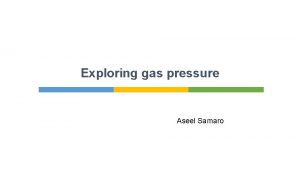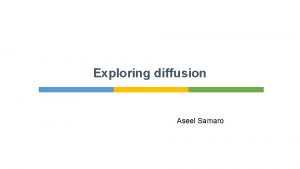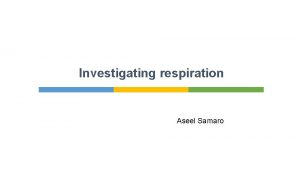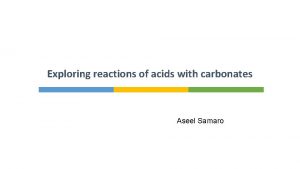Exploring how plants make food Aseel Samaro Introduction

















- Slides: 17

Exploring how plants make food Aseel Samaro



Introduction § Plants do not need to eat other plants or animals to get their food. § They make food using materials around them. What do they use to make food? How do they do it?

Making Food § Green plants use water from the environment and carbon dioxide from the air to make the sugar glucose. § Light from the Sun provides the energy needed for the reaction. § This process is called photosynthesis. The reaction also produces oxygen, which is released into the air during the daytime. § The plant uses the glucose for new growth and respiration and also stores unused glucose as a carbohydrate called starch.

These trees are giving out oxygen. Why is it important to conserve our trees?

Name the reactants in photosynthesis. Name the products of photosynthesis. Why does photosynthesis not happen at night? What will happen to the amount of carbon dioxide in the air during daylight? Why is light not a reactant or a product in the reaction?

Name the reactants in photosynthesis. carbon dioxide and water Name the products of photosynthesis. glucose and oxygen Why does photosynthesis not happen at night? Light is needed to give the energy for the reaction; at night there is no light energy for the reaction What will happen to the amount of carbon dioxide in the air during daylight? Why is light not a reactant or a product in the reaction? Light does not take part in the reaction; it provides the energy needed

Checking the evidence § You can show that a plant has photosynthesised by testing its leaves for starch. § This is done using a chemical called iodine. § Iodine is an orange colour, but it turns blue-black when added to starch. § First, the leaf needs to be boiled in ethanol and then rinsed in warm water. This kills the cells and removes the green colour. § Iodine is then added. If the leaf become blue-black, then starch is present, showing that photosynthesis has taken place.

Testing a leaf for starch: when a green leaf is boiled in alcohol the green colour is extracted. When iodine is added the leaf will turn blue-black if starch is present. leaf after extracting green colour leaf after iodine is added

A leaf has been kept in the light for five days. What colour will it be when tested with iodine? The leaf is then kept in the dark for five days. Now what colour will it be when tested when with iodine? Explain your answer. A leaf has been kept in a sealed jar without carbon dioxide for five days. What colour will it be when tested with iodine?

A leaf has been kept in the light for five days. What colour will it be when tested with iodine? Blue - black The leaf is then kept in the dark for five days. Now what colour will it be when tested when with iodine? Explain your answer. orange; starch only forms when light is available to provide the energy for the reaction A leaf has been kept in a sealed jar without carbon dioxide for five days. What colour will it be when tested with iodine? orange

The importance of green leaf § Leaves have a green colour because they contain a pigment called chlorophyll that absorbs light energy. § Chlorophyll is found in the chloroplasts in plant cells. § Look at the plant in the following figure. Some parts of its leaves are green and some parts are white. § Think about the process for testing a leaf for starch. § Like most activities, this process is not entirely free of risk. § You have to judge which risks are greatest and reduce these to a level that can be managed by sensible, safe behaviour.

This plant has variegated leaves.

What do you think would happen if you tested a leaf from the plant in the previous figure for starch? Explain your answer. The leaf would stay orange in the white areas; and turn blue-black in the green areas; showing that starch is only made in the areas containing chlorophyll What are the risks in the test for starch and how can they be controlled? risks: using boiling water; ethanol catching fire (it is flammable); iodine splashing and staining safety precautions: wearing safety glasses; turning the Bunsen off before using ethanol; using gloves to protect the hands; using forceps to remove the leaf from the hot water

Did you know…? § ‘Biomass’ is the total mass of an organism. § As plants photosynthesise and grow, their biomass increases.

Thank you
 How to identify pure aseel
How to identify pure aseel Aseel yousef
Aseel yousef Lab samaro
Lab samaro What is stomata
What is stomata Gc 101
Gc 101 Samaro property
Samaro property The steps of photosynthesis
The steps of photosynthesis Two raw materials necessary for photosynthesis
Two raw materials necessary for photosynthesis Green plants make their own food by photosynthesis
Green plants make their own food by photosynthesis How indoor plants make their food
How indoor plants make their food Nonvascular plants
Nonvascular plants Non vascular plant reproduction
Non vascular plant reproduction Characteristics of non flowering plants
Characteristics of non flowering plants C3 plant
C3 plant Unit 2 food food food
Unit 2 food food food Food chain food chain food chain
Food chain food chain food chain Best nitrogen source for plants
Best nitrogen source for plants Make the lie big, make it simple
Make the lie big, make it simple

